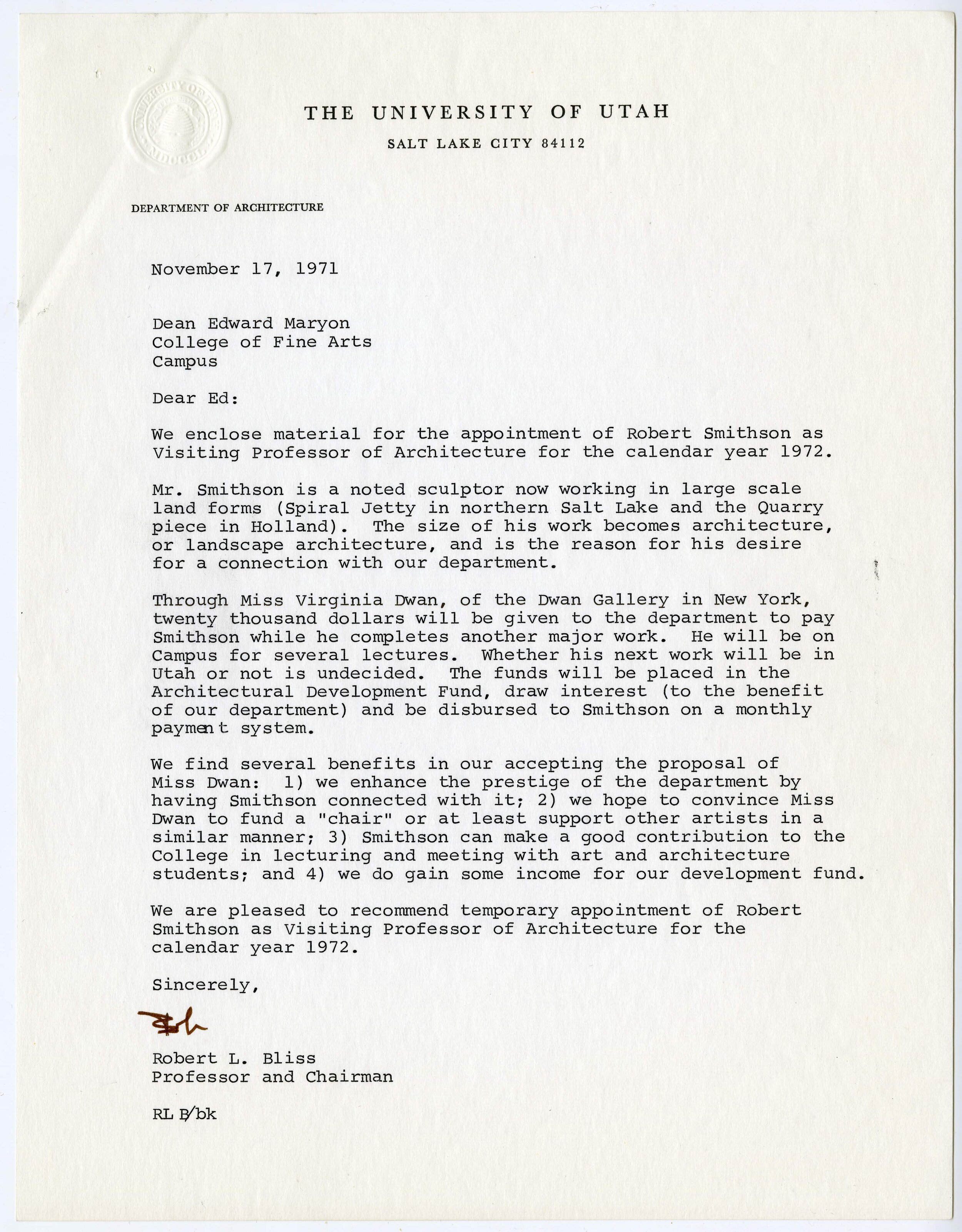Smithson Is Elsewhere: Robert Smithson at the University of Utah
On the occasion of Spiral Jetty’s fiftieth anniversary, the Utah Museum of Fine Arts invited several brilliant Utahns to share their perspectives. The following is an excerpt from a passage by Annie Burbidge Ream, Assistant Director of Learning and Engagement at the Utah Museum of Fine Arts, University of Utah, Salt Lake City.
“This is sort of the door. At first you notice right at the back that it’s green, right? There’s not really much you can say about it, I mean it’s just a green door. We’ve all seen green doors at one time in our lives. It gives out a sense of universality that way, a sense of kind of global cohesion. The door probably opens to nowhere and closes on nowhere so that we leave the Hotel Palenque with this closed door and return to the University of Utah.”
—Robert Smithson, Hotel Palenque, January 24, 1972
Fine Arts Auditorium, University of Utah
Robert Smithson is best known for Spiral Jetty (1970), his 1,500-foot-long, 15-foot-wide earthwork of basalt rocks that extends out into Utah’s Great Salt Lake at Rozel Point. However, the large earthwork is not the only evidence of the artist’s engagement with Utah. The permanent collection of the Utah Museum of Fine Arts has several works of art by Smithson including photographs, paintings, collages, drawings, and an original 1970 copy of the film Spiral Jetty that was recently rediscovered in the archives of the University of Utah’s Marriott Library. Also of note, Smithson was appointed visiting professor in the department of architecture at the University of Utah in 1972.
Two years prior, Robert Bliss, the chair of the University of Utah’s department of architecture, and Anna Campbell Bliss, artist and architect, were among some of the first to see Spiral Jetty. A mutual friend of the Blisses and Smithson, Jan van der Marck, was curator at the Walker Art Center in Minneapolis at the time. Van der Marck brought the Blisses to Spiral Jetty and eventually Smithson to the University of Utah. A year later, in the fall of 1971, Robert Bliss was introduced to Virginia Dwan, Smithson’s gallerist, at a social function at Spiral Jetty. Dwan approached him about the possibility of Smithson spending some time at the University of Utah in a teaching capacity. By November of that year, much of the paperwork was already in progress to appoint Smithson as a visiting professor. Initial conversations between Bliss and Dwan detail how Smithson would be on campus for several lectures, teach some graduate-level workshops, and plan a major work. In his initial letter proposing the appointment to Edward Maryon, the dean of the College of Fine Arts, Bliss lists four important benefits in accepting Dwan’s proposal to appoint Smithson to the position:
University of Utah historical faculty files, Acc. 526, Box 143. University Archives and Records Management. University of Utah, J. Willard Marriott. Salt Lake City, Utah
1) we enhance the prestige of the department by having Smithson connected with it;
2) we hope to convince Miss Dwan to fund a “chair” or at least support other artists in a similar manner;
3) Smithson can make a good contribution to the College in lecturing and meeting with art and architecture students; and 4) we do gain some income for our development fund.
For the entire account of Smithson’s time at the University of Utah as well as additional archival records, visit UMFA’s blog. For the complete 50 Years: Robert Smithson’s Spiral Jetty publication, click here.
Dia Art Foundation is proud to be the owner and steward of Smithson’s Spiral Jetty. Dia partners with the Great Salt Lake Institute at Westminster College, Holt/Smithson Foundation, and the Utah Museum of Fine Arts at the University of Utah to further advocate for Spiral Jetty. The Division of Forestry, Fire, and State Lands within the State of Utah’s Department of Natural Resources oversees the lake bed where Spiral Jetty is located.
Annie Burbidge Ream is the assistant director of learning and education and curator of education at the Utah Museum of Fine Arts (UMFA) in Salt Lake City, where she oversees the administration of K–12 school and teacher programs and manages the education collection. Ream uses works in the UMFA collection and museum resources to create hands-on, question-based experiences for teachers and students across the state of Utah. She also leads docent trainings emphasizing the importance of experiential learning. In 2016, Ream received the Utah Museum Educator of the Year award from the Utah Art Education Association as well as the Pacific Region Museum Education Art Educator award from the National Art Education Association.

